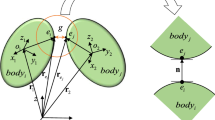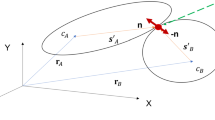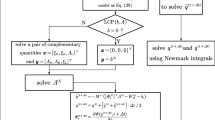Abstract
Nonsmooth dynamics algorithms have been widely used to solve the problems of frictional contact dynamics of multibody systems. The linear complementary problems (LCP) based algorithms have been proved to be very effective for the planar problems of frictional contact dynamics. For the spatial problems of frictional contact dynamics, however, the nonlinear complementary problems (NCP) based algorithms usually achieve more accurate results even though the LCP based algorithms can evaluate the friction force and the relative tangential velocity approximately. In this paper, a new computation methodology is proposed to simulate the nonsmooth spatial frictional contact dynamics of multibody systems. Without approximating the friction cone, the cone complementary problems (CCP) theory is used to describe the spatial frictional continuous contact problems such that the spatial friction force can be evaluated accurately. A prediction term is introduced to make the established CCP model be applicable to the cases at high sliding speed. To improve the convergence rate of Newton iterations, the velocity variation of the nonsmooth dynamics equations is decomposed into the smooth velocities and nonsmooth (jump) velocities. The smooth velocities are computed by using the generalized-\(\mathbf{a}\) algorithm, and the nonsmooth velocities are integrated via the implicit Euler algorithm. The accelerated projected gradient descend (APGD) algorithm is used to solve the CCP. Finally, four numerical examples are given to validate the proposed computation methodology.






























Similar content being viewed by others
Abbreviations
- \(g_{n}\) :
-
gap function
- \(P_{A},P_{B}\) :
-
contact candidate points
- \(\mathbf{f}\) :
-
vector of frictional contact force
- \(\mathbf{f}_{n}\) :
-
vector of normal contact force
- \(\mathbf{f}_{t}\) :
-
vector of tangential friction force
- \(\lambda _{n},\lambda _{u},\lambda _{w}\) :
-
frictional contact force components
- \(\mathbf{n}\) :
-
unit vector of normal contact direction
- \(\mathbf{u},\mathbf{w}\) :
-
unit vectors in the contact tangential plane
- \(P_{c}\) :
-
contact point
- \(\bar{\mathbf{v}}_{t}\) :
-
vector of relative tangential velocity
- \(\mu \) :
-
frictional coefficient
- \(\bar{v}_{n}\) :
-
relative normal velocity
- \(\bar{v}_{u}\) :
-
relative velocity along direction \(\mathbf{u}\)
- \(\bar{v}_{w}\) :
-
relative velocity along direction \(\mathbf{w}\)
- \(e\) :
-
restitution coefficient
- \(\bar{v}_{n}^{ +} \) :
-
relative normal velocity after an impact
- \(\bar{v}_{n}^{ -} \) :
-
relative normal velocity before an impact
- \(\mathbf{D}_{n},\mathbf{D}_{u},\mathbf{D}_{w}\) :
-
generalized directions along directions \(\mathbf{n}\), \(\mathbf{u}\) and \(\mathbf{w}\), respectively
- \(\mathbf{D}\) :
-
generalized direction matrix for unilateral constraints
- \(\tilde{\mathbf{D}}\) :
-
generalized direction matrix for continuous contacts
- \(\hat{\mathbf{D}}\) :
-
generalized direction matrix for transient impacts
- \(h\) :
-
integration time step
- \(\xi \) :
-
Lagrange multiplier for the KKT conditions
- \(FC\) :
-
friction cone
- \(FC^{o}\) :
-
polar cone of the friction cone
- \(FC_{i}\) :
-
friction cone for the \(i\)th contact pair
- \(FC_{i}^{o}\) :
-
polar cone for the \(i\)th friction cone
- \(C\) :
-
complete friction cone
- \(C^{o}\) :
-
polar cone of the complete friction cone
- \(\mathbf{q}\) :
-
generalized coordinates
- \(\mathbf{M}\) :
-
mass matrix of system
- \(\mathbf{v}\) :
-
vector of generalized velocities
- \(\tilde{\mathbf{v}}\) :
-
vector of smooth generalized velocities
- \(\hat{\mathbf{v}}\) :
-
vector of nonsmooth generalized velocities
- \(\boldsymbol{\Phi } \) :
-
vector of bilateral constraints
- \(\boldsymbol{\Phi }_{\mathbf{q}}\) :
-
Jacobi of vector of bilateral constraints
- \(\mathbf{F}\) :
-
vector of generalized forces
- \(\boldsymbol{\lambda }_{b}\) :
-
vector of Lagrange multipliers for bilateral constraints
- \(\boldsymbol{\lambda }_{u}\) :
-
vector of reaction forces of smooth unilateral constraints
- \(\boldsymbol{\Lambda }_{u}\) :
-
vector of reaction impulses of nonsmooth unilateral constraints
- \(\delta _{t_{j}}\) :
-
Dirac delta function at an instant \(t_{j}\)
- \(\prod_{C}\) :
-
projection function of the domain \(C\)
-
 :
: -
generalized-a algorithm parameters
- \(\theta ,\zeta \) :
-
APGD algorithm parameters
References
Acary, V., Brogliato, B.: Numerical Methods for Nonsmooth Dynamical Systems: Applications in Mechanics and Electronics. Springer, Berlin (2008)
Studer, C.: Numerics of Unilateral Contact and Friction: Modeling and Numerical Time Integration in Nonsmooth Dynamics. Springer, Berlin (2009)
Tian, Q., Flores, P., Lankarani, H.M.: A comprehensive survey of the analytical, numerical and experimental methodologies for dynamics of multibody mechanical systems with clearance or imperfect joints. Mech. Mach. Theory 122, 1–57 (2018)
Nakashima, H., Oida, A.: Algorithm and implementation of soil–tire contact analysis code based on dynamic FE–DE method. J. Terramech. 41, 127–137 (2004)
Dufva, K., Kerkkänen, K., Maqueda, L.G., Shabana, A.A.: Nonlinear dynamics of three-dimensional belt drives using the finite-element method. Nonlinear Dyn. 48, 449–466 (2007)
Machado, M., Moreira, P., Flores, P., Lankarani, H.M.: Compliant contact force models in multibody dynamics: evolution of the hertz contact theory. Mech. Mach. Theory 53, 99–121 (2012)
Dubois, F., Acary, V., Jean, M.: The contact dynamics method: a nonsmooth story. C. R., Méc. 346, 247–262 (2018)
Leine, R.I., Glocker, C.: A set-valued force law for spatial Coulomb–Contensou friction. Eur. J. Mech. A, Solids 22, 193–216 (2003)
Cottle, R., Pang, W.: The Linear Complementarity Problem. Academic Press, London (1992)
Murty, K.G.: Linear Complementarity, Linear and Nonlinear Programming. Heldermann, Berlin (1988)
Lötstedt, P.: Coulomb friction in two-dimensional rigid body systems. Z. Angew. Math. Mech. 61, 605–615 (1981)
Lötstedt, P.: Mechanical systems of rigid bodies subject to unilateral constraints. SIAM J. Appl. Math. 42, 281–296 (1982)
Moreau, J.J.: Unilateral contact and dry friction in finite freedom dynamics. In: Moreau, J.J., Panagiotopoulos, P.D. (eds.) Nonsmooth Mechanics and Applications, pp. 1–82. Springer, Vienna (1988)
Moreau, J.J.: Numerical aspects of the sweeping process. Comput. Methods Appl. Mech. Eng. 177, 329–349 (1999)
Schatzman, M.: A class of nonlinear differential equations of second order in time. Nonlinear Anal., Theory Methods Appl. 2, 355–373 (1978)
Al-Fahed, A.M., Stavroulakis, G.E., Panagiotopoulos, P.D.: A linear complementarity approach to the frictionless gripper problem. Int. J. Robot. Res. 11, 112–122 (1992)
Flores, P., Leine, R., Glocker, C.: Modeling and analysis of planar rigid multibody systems with translational clearance joints based on the non-smooth dynamics approach. Multibody Syst. Dyn. 23, 165–190 (2010)
Čepon, G., Boltežar, M.: Dynamics of a belt-drive system using a linear complementarity problem for the belt–pulley contact description. J. Sound Vib. 319, 1019–1035 (2009)
Pfeiffer, F., Foerg, M., Ulbrich, H.: Numerical aspects of non-smooth multibody dynamics. Comput. Methods Appl. Mech. Eng. 195, 6891–6908 (2006)
Klarbring, A.: A mathematical programming approach to three-dimensional contact problems with friction. Comput. Methods Appl. Mech. Eng. 58, 175–200 (1986)
Miller, A.T., Christensen, H.I.: Implementation of multi-rigid-body dynamics within a robotic grasping simulator. IEEE Int. Conf. Robot. Autom. 2, 2262–2268 (2003)
Pfeiffer, F.: Non-smooth engineering dynamics. Meccanica 51, 3167–3184 (2016)
Tasora, A., Anitescu, M.: A matrix-free cone complementarity approach for solving large-scale, nonsmooth, rigid body dynamics. Comput. Methods Appl. Mech. Eng. 200, 439–453 (2011)
Yu, X., Matikainen, M.K., Harish, A.B., Mikkola, A.: Procedure for non-smooth contact for planar flexible beams with cone complementarity problem. Proc. Inst. Mech. Eng., Part K, J. Multi-Body Dyn. (2020)
Anitescu, M., Tasora, A.: An iterative approach for cone complementarity problems for nonsmooth dynamics. Comput. Optim. Appl. 47, 207–235 (2010)
Negrut, D., Serban, R., Tasora, A.: Posing multibody dynamics with friction and contact as a differential complementarity problem. J. Comput. Nonlinear Dyn. 13, 014503 (2018)
Mazhar, H., Heyn, T., Negrut, D., Tasora, A.: Using Nesterov’s method to accelerate multibody dynamics with friction and contact. ACM Trans. Graph. 34, 1–14 (2015)
Negrut, D., Rampalli, R., Ottarsson, G., Sajdak, A.: On an implementation of the Hilber-Hughes-Taylor method in the context of index 3 differential-algebraic equations of multibody dynamics (DETC2005-85096). J. Comput. Nonlinear Dyn. 2, 73–85 (2007)
Arnold, M., Brüls, O.: Convergence of the generalized-\(\alpha \) scheme for constrained mechanical systems. Multibody Syst. Dyn. 18, 185–202 (2007)
Paoli, L., Schatzman, M.: A numerical scheme for impact problems I: the one-dimensional case. SIAM J. Numer. Anal. 40, 702–733 (2002)
Paoli, L., Schatzman, M.: A numerical scheme for impact problems II: the multidimensional case. SIAM J. Numer. Anal. 40, 734–768 (2002)
Acary, V.: Higher order event capturing time-stepping schemes for nonsmooth multibody systems with unilateral constraints and impacts. Appl. Numer. Math. 62, 1259–1275 (2012)
Chen, Q., Acary, V., Virlez, G., Brüls, O.: A nonsmooth generalized-\(\alpha \) scheme for flexible multibody systems with unilateral constraints. Int. J. Numer. Methods Eng. 96, 487–511 (2013)
Cavalieri, F.J., Cardona, A.: Non-smooth model of a frictionless and dry three-dimensional revolute joint with clearance for multibody system dynamics. Mech. Mach. Theory 121, 335–354 (2018)
Brüls, O., Acary, V., Cardona, A.: Simultaneous enforcement of constraints at position and velocity levels in the nonsmooth generalized-\(\alpha \) scheme. Comput. Methods Appl. Mech. Eng. 281, 131–161 (2014)
Cosimo, A., Galvez, J., Cavalieri, F.J., et al.: A robust nonsmooth generalized-\(\alpha \) scheme for flexible systems with impacts. Multibody Syst. Dyn. 48, 127–149 (2020)
Galvez, J., Cavalieri, F.J., Cosimo, A., Brüls, O., Cardona, A.: A nonsmooth frictional contact formulation for multibody system dynamics. Int. J. Numer. Methods Eng. 121, 3584–3609 (2020)
Anitescu, M., Potra, F.A.: Formulating dynamic multi-rigid-body contact problems with friction as solvable linear complementarity problems. Nonlinear Dyn. 14, 231–247 (1997)
Stewart, D.: Rigid-body dynamics with friction and impact. SIAM Rev. 42, 3–39 (2000)
Anitescu, M., Hart, G.D.: A constraint-stabilized time-stepping approach for rigid multibody dynamics with joints, contact and friction. Int. J. Numer. Methods Eng. 60, 2335–2371 (2004)
Acary, V., Brémond, M., Huber, O.: On solving contact problems with Coulomb friction: formulations and numerical comparisons. In: Leine, R., Acary, V., Brüls, O. (eds.) Advanced Topics in Nonsmooth Dynamics, pp. 375–457. Springer, Cham (2018)
Acary, V., Cadoux, F., Lemaréchal, C., Malick, J.: A formulation of the linear discrete Coulomb friction problem via convex optimization. Z. Angew. Math. Mech. 91, 155–175 (2011)
Cebulla, T.H.: Spatial dynamics of pushbelt CVTs: model enhancements to a non-smooth flexible multibody system. Ph.D., Technical University of Munich (2014)
García, J.J., Bayo, E.: Kinematic and Dynamic Simulation of Multibody Systems: The Real-Time Challenge. Springer, New York (1994)
García-Vallejo, D., Mikkola, A.M., Escalona, J.L.: A new locking-free shear deformable finite element based on absolute nodal coordinates. Nonlinear Dyn. 50, 249–264 (2007)
Liu, C., Tian, Q., Hu, H.Y.: New spatial curved beam and cylindrical shell elements of gradient-deficient Absolute Nodal Coordinate Formulation. Nonlinear Dyn. 70, 1903–1918 (2012)
Acknowledgements
This work was supported in part by the National Natural Science Foundation of China under Grants 11722216, 11832005 and by the 111 China Project (B16003). We also would like to thank the two anonymous referees for their professional reviews and insightful comments, which have led us to improve the quality of the manuscript.
Author information
Authors and Affiliations
Corresponding author
Ethics declarations
Declaration on conflict of interest
The authors declared no potential conflicts of interest with respect to the research, authorship, and publication of this article.
Additional information
Publisher’s Note
Springer Nature remains neutral with regard to jurisdictional claims in published maps and institutional affiliations.
Appendix
Appendix
1.1 A.1 Dynamic equation of the rigid sliding rod
As shown in Fig. 31, a rigid rod is subject to oblique sliding under the action of gravity. The length of the rod is \(l\), \(\mu \) denotes the friction coefficient. According to the normal and tangential contact forces shown in Fig. 31, it is straightforward to establish the dynamic equations of the rod as follows:
where \(r\) denotes the cross-sectional radius of the rod and \(J\) is the moment of inertia of the rod, satisfying
The coordinates of the rod mass center yield
Substituting Eqs. (41), (42), (38) and (39) into Eq. (40) gives the dynamic equation of the sliding rod as follows:
Given the initial condition of the rod as \(\theta = \pi /4, \dot{\theta } = 0\), Fig. 13 and Fig. 14, show the numerical solutions of Eq. (43). According to the results, the normal contact force \(F_{2}\) becomes negative after the moment 0.271 s when the rod gets separated from the vertical wall.
Rights and permissions
About this article
Cite this article
Wang, K., Tian, Q. & Hu, H. Nonsmooth spatial frictional contact dynamics of multibody systems. Multibody Syst Dyn 53, 1–27 (2021). https://doi.org/10.1007/s11044-021-09786-w
Received:
Accepted:
Published:
Issue Date:
DOI: https://doi.org/10.1007/s11044-021-09786-w





 :
: